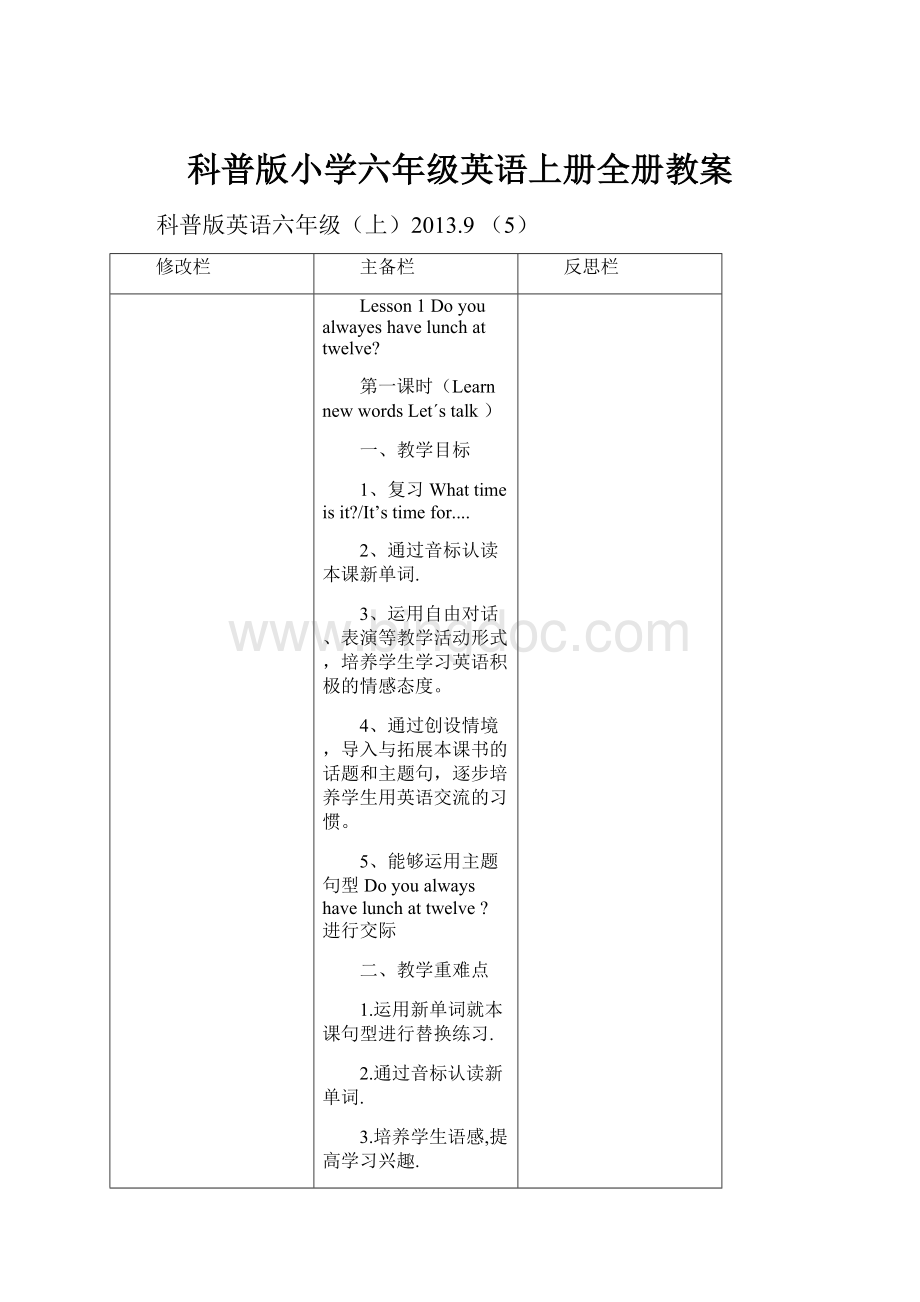科普版小学六年级英语上册全册教案.docx
《科普版小学六年级英语上册全册教案.docx》由会员分享,可在线阅读,更多相关《科普版小学六年级英语上册全册教案.docx(172页珍藏版)》请在冰点文库上搜索。

科普版小学六年级英语上册全册教案
科普版英语六年级(上)2013.9(5)
修改栏
主备栏
反思栏
Lesson1Doyoualwayeshavelunchattwelve?
第一课时(LearnnewwordsLet´stalk)
一、教学目标
1、复习Whattimeisit?
/It’stimefor....
2、通过音标认读本课新单词.
3、运用自由对话、表演等教学活动形式,培养学生学习英语积极的情感态度。
4、通过创设情境,导入与拓展本课书的话题和主题句,逐步培养学生用英语交流的习惯。
5、能够运用主题句型Doyoualwayshavelunchattwelve?
进行交际
二、教学重难点
1.运用新单词就本课句型进行替换练习.
2.通过音标认读新单词.
3.培养学生语感,提高学习兴趣.
三、课堂导引
Step1Warm-up
Freetalkaboutpersonalinformations
(自由对话营造英语会话氛围,个人信息话题为本课主题句奠定下基础)
Step2Revision
Reviewsummaryoflesson1-6
Step3Presentation
1.Learnnewwordsoflessonone
Readallthewordsoflessononeaccordingtothephoneticsymblesbythemselves.
(让学生根据音标自学单词,培养学生自学意识)
2.Learnblackwords.(Readandspelling)
3.Practice(readthewordcards)
Step4Presentation(Let’stalk)
1.Guiding
Takeoutaclockandask:
whattimeisit?
Thestudentwillanswer:
It’stwelve.Thentheteachersay:
Oh,yesit’stimeforlunch.Theteacherask:
Doyoualwayshavelunchattwelve?
Helpthestudentsanawer:
Yes,Ido.
2.Showthetopic
OK,todaywewilllearnlessonone:
Doyoualwayshavelunchattwelve?
(Writethetopicontheblackboard,以旧引新,循序渐进的导入,减低学习难度)
3.Let’talk__newdialogue
a.Readthedialoguebythemslvesforonetime
b.Lookatthebooksandlistentothetape
C.Listentothetapeandrepeatfortwice.
(学生先自渎可发现自己不会的地方,便会有目的的去听,然后再重点跟度自己不会的句子,有目的的去听会很有效的提高学生的听力。
)
d.Understand
Explaindifficultsentences:
Iusuallyhavelunchateleventhirty.SometimesIhavelunchattwelve.
Whatdoyouusuallyhaveforlunch?
e.Present__reading
(为学生解决难点后再练读可提高学生阅读兴趣及能力)
Step4Practice
Reading
[在操练时可采用多种形式,如跟读、分组读、分角色读,通过朗读培养学生正确的语音、语调,而小组内的合作学习,更是新课标中要求培养学生合作精神的具体体现]
Step5ConsolidationandCreation(巩固与创新)
1.Actthedialogueonthebook
(电脑操作:
屏幕显示本课对话画面,学生看画面进行对话)
2.Makeupnewdialogue
(电脑操作:
屏幕显示新画面,出示一块钟表及一种食物,学生仿照以上对话编排新的对话,培养学生创新精神及新知识运用能力)
Step6Classclosing
1.Listentothemusic__themusicroom
2.Homework,doexercise7ontheexercisesbook.
4、词汇沙龙
1.It’stimetodosth.=It’stimeforsth.该做。
。
。
的时候到了
2.wakeup醒来
3.havelunch吃午饭
4.domorningexercises做早操
5、巩固练习
1.It’stime_____lunch.
A.for B.to C.in
2.Johnusually_____upat6:
20.
A.wake B.wakes C.waking
3.——Doyouusuallyhavelunchat12:
00?
——Yes,I_______.
A.doB.doesC.todo
4.Doesshe_____morningexerciseshereeveryday?
A.doesB.doingC.do
5._____doyouhave_____lunch?
A.WhereinB.WhatinC.Whatfor
第二课时(let’slearnnewLet´ssingLet´spractise)
一、教学目标
1.掌握本课主题句型,并进行替换练习。
2.运用新句型编排对话。
3.培养学生创造性思维。
二、教学重难点
1.掌握本课句型。
并进行替换练习。
2.让学生创造性的学习新知。
三、课堂导引
Step1.Revision
1.Readthe“let’stalk”ofthislesson
2.Freetalkaboutdaylylife.
Whattimeisit?
It’stimefor...
Doyoualways...?
Step2.Presentation
1.Guide
Showpictures
(电脑操作,屏幕显示let’slearn,model图片)
Listentothetape,thisis“atalk”betweenEveandTom.Let’slistenhowdothey
Talkaboutthesametopicaboutyourself.
(通过本环节来拓展学生思维,同时有可把话题引入现实生活,使得学有所用)
2.Act
NowIamEve,andyouareTom,pleaseanswermyquestions.
T:
Doyouusuallyhavebreakfsatatseven?
Ss:
Yes,Ido.
T:
Whatdoyouhaveforbreakfast?
Ss:
Iusuallyhvemilkandbread.
3.Practice
Askandanswerquestionsabouttheothertwopictures,assameaslaststep,intheirgroups
4.Check
Asksomestudentstostandupandacttheirdialogues.
Smunication
Talkaboutthesametopicaboutyourself.
(通过本环节来拓展学生思维,同时有可把话题引入现实生活,使得学有所用)
Step4Writing
Copythemodeldialogueoflet’slearnontheexercisebooks.
(在学生问答,听说操练到一定程度是,让学生练习一些句子的书写,进一步加强对该句子的理解和巩固,以真正达到听说为先,读写跟上。
)
Step5.Homework
Finishoffwritingaboutlet’slearn.
四、词汇沙龙
(1)Therebe某处存在某物
(2)常见的频度副词有:
always(100%的频度),表“总是,常常”,侧重时间的连续性;
usually(80%--90%的频度),表“通常”,强调习惯性,经常如此;
often(50%--70%的频度),表“经常,”指有规律的经常出现‘
sometimes(30%--50%的频度),表“有时候”,指偶尔出现;
never(0%的频度),表“从来不”,表示一种习惯。
5、巩固练习
1.Hisfatheralways_____himtoschoolat8:
00.
A.takesB.totakeC.take
2.SometimesAmy_____TVintheevening.
A.watchB.watchingC.watching
3.Henever_____thefloor.
A.mopB.moppingC.mops
4.Shealways_____breakfastat7:
00.
A.makeB.makesC.making
5.Doesshealways_____sportsat9:
00.
A.doesB.doC.doing
第三课时(Read)
一、教学目标
1.Readandunderstand“Read”
2.Answersomequestionsabout“Read”
3.Graspsomephrases
4.Improvethereadingandcomprehentionablity.
二、教学重难点
Improvethereadingandcomprehentionablity
三、课堂导引
Step1.Warmup(freetalk)
Whattimeisit?
Doyoualwayshavebreakfastatseven?
Whatdoyouusuallyhaveforlunch?
Doyoualwaysgettoschoolatseven?
Areyoualwayslateforschool?
(Thelastquestionshouldbeaskedsomemoretimes,inordertoguidethenewtopic)
Step2.Newcontent
1.Guide
T:
OK,Iknowallofyoudon’tlikebeinglateforschool.ButmaybetodayJohnislateforschool,isJihnreallylateforschool?
Nowpleaselistentohisstory.
2.Introduce
AsktheSslookatthirbooks,theteacherintrduce“readforfun”,picturebypicture.
(学生知道故事大概意思)
3.Listentothetape
Ifyoudon’tknowthestorysowellnow,pleaselistentothrtapecarefully.
(学生再次了解课文)
3.Readingandcomprehension
a.Ifyouwanttounderstanditwellenough,youmustreaditbyyourself
(进一步了解课文,同时训练学生的阅读能力)
b.Readingthequedtionsatfirstthenreadthetextagain,thenanswerthequestions.
(带着问题去读,促使学生在阅读的同时加以理解,培养学生的阅读理解能力)
Questions:
1.WhattimeisitwhenJohnwakesup?
2.DoesJohndomorningexerciseseveryday?
3.DoesJohndomorningexercisestoday?
4.Ishismotherinthekitchenthismorning?
5.Whotakeshimtoschooleverymorning?
6.WhattimeisitwhenJohngetstoschool?
7.Ishereallylateforschooltoday?
Why?
Step3.Practice
Exercise9Readingandcomprehensionontheexercisebook.
Step4Homework
Finishofftheexercisesontheexercisebook.
4、词汇沙龙
havenotime没有时间
either,也…通常用在否定句末尾
makebreakfast做早饭
there’ssomethingwrongwith……出毛病了
5、巩固练习
1.Thereissomethingwrong______hisclock.
A.to B.with C.At
2.Buttodayhehas_____time.
A.no B.not C.isn’t
3.Ihavenotime_____morningexercises.
A.do B.todo C.Doing
4.Heisalwayslate______school.
A.forB.atC.of
Lesson2Doesshealwayscomehere?
第一课时:
learnnewwordsLet’slearnLet’schant.
一、教学目标
1、复习单词:
alwaysusuallyriceearlywakeupanyonewrong
2、复习句子:
Doyouusuallyhavelunchattwelve?
Yes,Ido.\No,Idon’t.
3、学习Let’slearn的重点句型。
4、通过创设情境,导入与拓展本课书的话题和主题句,逐步培养学生用英语交流的习惯。
5、能够运用主题句型Doessheusuallyhavelunchattwelve?
Yes,shedoes.\No,shedoesn’t.进行交际。
二、教学重难点
掌握主题句型Doessheusuallyhavelunchattwelve?
Yes,shedoes.\No,shedoesn’t
并能用替换词造句和做出正确回答。
三、课堂导引
Freetalk:
学生表演课前准备的对话(叫三组学生)
[学生养成良好的习惯,在课下也能主动的和同组的同学练习口语,激发学生学英语的兴趣。
]
Step1Revision
一、听写单词:
alwaysusuallyriceearlywakeupanyonewrong
二、复习句型Doyouusuallyhavelunchattwelve?
Yes,Ido.\No,Idon’t
(用短语watchTvdoone’shomeworkdosportsplayfootball进行替换练习)同时进行板书
[复习第五册和上节课学过的重点句型,为传授新知,做对比练习做准备]
Step2Presentation
一、Leantheshortsentences:
takeawalkdosportswatchTV
afterlunch\supper\class\school
二、Practice教师说汉语学生说英语或反之
三、Practicethissentenceswiththeseshortsentences:
Doyouusuallytakeawalkaftersupper?
Yes,Ido.\No,Idon’t.
采用师生问答、生生问答的形式练习新学的短语。
四、出示两幅简笔画:
小男孩作早操、一位男士散步
Ask:
DoesMingmingdomorningexerciseseverymorning?
(板书)
DoyouusuallywatchTVaftersupper?
(板书)
(让学生把这两句话进行比较问:
两句话有什么不同让学生进行讨论教师进行总结:
在一般现在时态句子中当主语是第三人称单数时谓语动词要加s或es)
[用对比的方法来学习新知,合理的利用了正迁移,让学生自己动脑筋来探究知识的不同,强化知识难点,使学生记忆更加深刻]
五、Practicethesenewsentences:
DoesLeledomorningexerciseseverymorning?
Yes,hedoes.\No,hedoesn’t.
(学生利用书中Let’slearn中的短语同桌两个人先进行练习,然后小组内进行)
Step3Practice
教师检查练习的效果
教师根据生活中的实际进行问答:
如
问同桌两个人不同的问题:
A:
Doyouusuallydomorningexercise?
B:
Doesshe\heusuallydomorningexercise?
(还是利用对比的方法来强化本课知识的难点,让学生处处注意到本课的难点.)
Step4Let’schant.
教师放两遍录音
domybest(尽力)
worryabout(担心)
Step5Homework
利用Let’slearn中的短语编四句话写在作业本上.
四、词汇沙龙
takeawalk=goforawalk散步
dosports做运动
Aftersupper晚饭后
Intheafternoon在下午
WatchTV看电视
Intheevening在晚上
domybest(尽力)
worryabout(担心)
5、巩固练习
1.---DoyouwatchTVtheevening?
---No,Idon"t.
AinBatCof
2.----Doesheplayfootballlunch?
----No,hedoesn"t.
AinBafterCof
3.Johnusually_____at6:
20.
AwatchTVBwatchsTVCwatchesTV
4.Ineedn’tmytest.
AworrysaboutBworriedaboutCworryabout
第二课时:
Let’talk.
一、教学目标
1、学习Let’talk.
2、运用自由对话、表演等教学活动形式,培养学生学习英语积极的情感态度。
4、通过创设情境,导入与拓展本课书的话题和主题句,逐步培养学生用英语交流的习惯
5、巩固练习
二、教学重难点
1、对本课知识点的巩固
2、培养学生的语感
三、课堂导引
Freetalk
日常交际对话(包含第一课中的主题句)
Step1Revision
1、RevisethesentencesofLessonOne.
T:
Doyouusuallyhavebreakfastatseven?
Ss:
Yes,Ido.
T:
Whatdoyouhaveforbreakfast?
Ss:
Iusuallyhveemilkandbread.
3、RevisethesentencesofLessonTwo.
T:
Doessheusuallyhavebreakfastatseven?
Ss:
Yes,shedo.
T:
Whatdoesshehaveforbreakfast?
Ss:
Sheusuallyhavemilkandbread.
Step2Presentation(Let’stalk)
1、Listentothetape
2、Repeat.
3、让学生勾画出本课的主题句:
Doesshedomorningexerciseshereeveryday?
Yes,shedoes.
Doesshealwayscomebeforesixthirty?
Yes,shedoes.
(学生翻译句子教师强调本主题句需注意的地方)
4、以小组合作的形式翻译其余的句子
5、教师讲解知识点:
Whattimeisit?
What’sthetime?
(以上两句为同意句都是“几点了”的意思)
Step3Practice
Reading
Readaftertheteacher.
Readtogether
[在操练时可采用多种形式,如跟读、分组读、分角色读,通过朗读培养学生正确的语音、语调,而小组内的合作学习,更是新课标中要求培养学生合作精神的具体体现]
Step5ConsolidationandCreation
1.Actthedialogueonthebook
(出示教学挂图或多媒体课件,男女生分开角色读)
2.Actthedialogue
(学生不看书来表演)
四、巩固练习
1Iusually()lunchattwelve.
2Sheusually()lunchattwelve,too.
3We’re()havelunchnow.
4()youusuallydomorningeverymorning.
5()Lelealwayswatchtvaftersupper.
6Sheis()TVeverymo